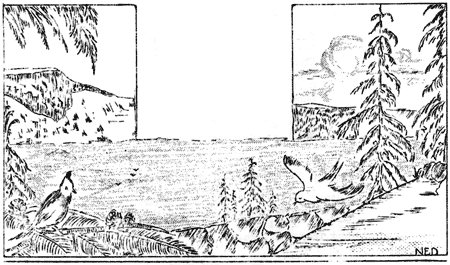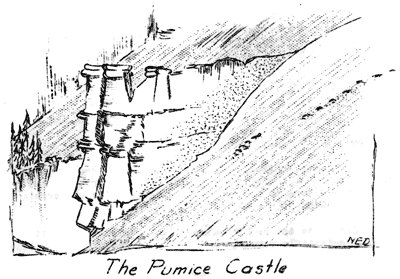It may be seen from the above lists that certain birds like the Siskins, Juncos, Audubon’s Warblers, Chickadees, Chipping Sparrows, and Olive-sided Flycatchers are widely distributed in the park. The lists explain too, why many tourists comment on the poverty of bird life in the park. Tourists spend most of their time along the rim where possibly because of the ubiquity of the Clark’s Nutcrackers, very few species are to be found. At elevations lower than the rim, especially in the well watered valleys, twice as many species may easily be observed.
Of the many colorful volcanic formations in the walls surrounding Crater Lake, The Pumice Castle, on the east wall, attracts the attention of all visitors making the launch trip around the lake, and of many visitors viewing the crater walls from the rim, particularly when the afternoon sunlight emphasizes the pattern of color on the east wall.
The Pumice Castle is part of an extensive lenticular bed of fragmental pumice outcropping on the crater wall about 1,300 feet above the level of the lake, or 400 feet below the crater rim just south of Cloudcap. The bed of pumice has a maximum thickness of 190 feet. Below it much of the section of the crater wall is hidden by talus, except for a few thin layers of lava and beds of fragmental material. Immediately above the lenticular bed of pumice is a thick, massive bed of andesite. Above the andesite occurs the pumice which mantles the remnants of Ancient Mount Mazama and the region extending for many miles beyond.
Following is a measured section from the top to the bottom of The Pumice Castle.
4 feet of brownish red fragmental pumice
2 feet of light buff to pink fragmental pumice
4 feet of brownish red fragmental pumice
60 feet of gray fragmental pumice
60 feet of reddish brown fragmental pumice
6 feet of black obsidian
30 feet of brownish red fragmental pumice
4 feet of brown andesite containing numerous small lenses of black obsidian
20 feet of reddish brown fragmental pumice
A study of the section, composed of layers of hard, resistant material such as the andesite and obsidian interspersed in the soft, less resistant layers of fragmental pumice, explains why erosion has produced the castle-like feature.
In addition to the scenic value of The Pumice Castle, it is a significant scientific feature in that it is evidence of a pumice eruption which occurred earlier than the ejection of material represented by the great thickness of pumice exposed at the top of the crater wall, and which mantles the region of miles beyond the crater rim.
Beds of fragmental pumice, similar to that exposed at The Pumice Castle, are exposed at several places in the north wall. At the Llao Rock flow and at Palisade Point the pumice occurs beneath thick lava flows. Whether these lenticular outcrops of pumice are of the same age, or represent material ejected during one eruption, has as yet not been determined. Field studies to date suggest that they represent material ejected during one eruption. From further field studies it may be possible to determine not only whether the pumice was ejected during one eruption but also to determine the approximate location of the vent or vents from which the material was ejected.
The Pumice Castle, the product of volcanic activity and erosion, exemplifies the combination of scenic and scientific values typical of Crater Lake, scenic in that its coloring and architecture stimulate the imagination, scientific in that it tells part of the story of the building and destruction of Mount Mazama.
This is a report of the second creel census for Crater Lake. The first report by Hasler (Nature Notes, July and August 1937) when compared with this shows a decrease in the number of fish caught. Table 1 summarizes the data for the 1938 fishing season, the season being considered as from July 1 to September 1, the period when boats are available. In July 1937 the catch per hour per fisherman was 0.83 fish; for July 1938 the catch amounted to 0.52 fish. In August 1937 the catch per hour was 0.66 fish; for August 1938 it was 0.39 fish. During both the 1937 and 1938 seasons the August fishing season showed a slump over July. While the yield of fish during the 1938 season shows a decrease over that for 1937 the quality of the fish caught during 1938 was quite satisfactory and equal to last year.





